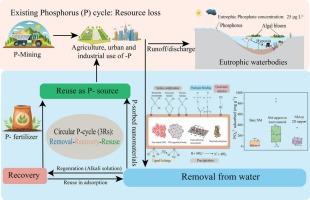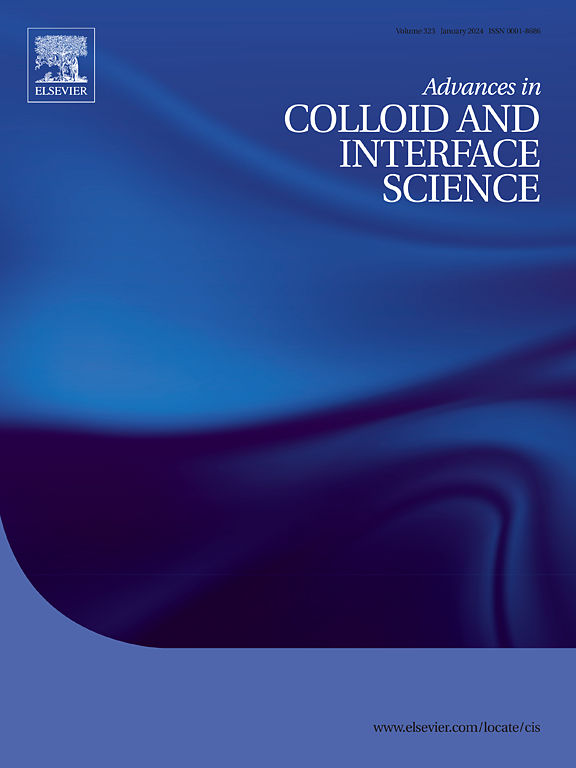去除、回收和再利用磷的工程纳米材料:从水到肥料的途径
IF 19.3
1区 化学
Q1 CHEMISTRY, PHYSICAL
引用次数: 0
摘要
随着富营养化对生物多样性和全球经济的持续危害,水体中磷的去除日益受到关注。与此同时,作为植物施肥的重要资源的有限磷矿储量的枯竭,凸显了寻找可持续替代品的紧迫性。纳米材料可以提供高效的除磷技术,结合从水体中回收吸附磷的有效手段,可以作为磷肥的可持续来源,替代磷矿。本文主要探讨了纳米材料(NMs)在磷管理的3-Rs中的作用:去除、回收和再利用,重点介绍了它们的去除性能、机制和潜在应用。我们的分析强调,金属氧化物纳米材料在支撑基质(如粘土、生物炭、二维材料)上的沉积和它们在聚合物基质中的包裹显著提高了去除效率。去除过程是表面控制的,受纳米材料性质、溶液化学和竞争离子的影响。在各种情况下评估了p吸附纳米材料的回收和再利用,强调了它们的未来潜力,并提出了提高性能的改进措施。虽然纳米材料有望推动循环经济,但迫切需要大规模的现场实验来验证其实际适用性,并支持实现联合国可持续发展目标。本文章由计算机程序翻译,如有差异,请以英文原文为准。

Engineered nanomaterials for removal, recovery, and reuse of phosphorus: From water to fertilizer pathways
Phosphorus (P) removal from water bodies is gaining attention as eutrophication continues to harm biodiversity and the global economy. At the same time, the depletion of finite rock phosphate reserves, a vital resource for plant fertilization, highlights the urgency of sustainable alternatives. Nanomaterials can offer efficient P removal techniques integrated with efficient means of recovering adsorbed P from the water bodies, which could serve as a sustainable source of P fertilizers, an alternative to rock phosphate. This review critically explores the role of nanomaterials (NMs) in the 3-Rs of P management: removal, recovery, and reuse, with a focus on their removal performance, mechanisms, and potential applications. Our analysis highlights that the deposition of metal oxide nanomaterials on support matrices (e.g., clay, biochar, 2D materials) and their entrapment in polymer matrices significantly enhances removal efficiency. The removal process is surface-controlled, influenced by nanomaterial properties, solution chemistry, and competing ions. The recovery and reuse of P-sorbed nanomaterials are evaluated under various scenarios, emphasizing their future potential and proposing improvements to enhance performance. While nanomaterials are promising to advance a P circular economy, large-scale field experiments are critically needed to validate their practical applicability and support the achievement of the United Nations' Sustainable Development Goals.
求助全文
通过发布文献求助,成功后即可免费获取论文全文。
去求助
来源期刊
CiteScore
28.50
自引率
2.60%
发文量
175
审稿时长
31 days
期刊介绍:
"Advances in Colloid and Interface Science" is an international journal that focuses on experimental and theoretical developments in interfacial and colloidal phenomena. The journal covers a wide range of disciplines including biology, chemistry, physics, and technology.
The journal accepts review articles on any topic within the scope of colloid and interface science. These articles should provide an in-depth analysis of the subject matter, offering a critical review of the current state of the field. The author's informed opinion on the topic should also be included. The manuscript should compare and contrast ideas found in the reviewed literature and address the limitations of these ideas.
Typically, the articles published in this journal are written by recognized experts in the field.

 求助内容:
求助内容: 应助结果提醒方式:
应助结果提醒方式:


